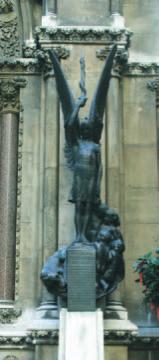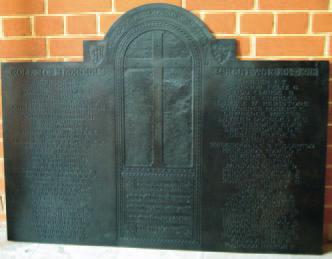Basic HTML Version


BCD Special Report on
Historic Churches
18th annual edition
13
and vulnerability. Sometimes the original
creators of a memorial have long vanished and
it is not unknown for memorials to be sold,
moved into storage or destroyed. Sometimes
they have been subject to vandalism and
inevitably they are eroded by physical decay.
Current economic conditions offer a further
threat with war memorials squeezed of the
often minimal resources they receive.
WMT has a clear purpose as an
independent charity to identify war memorials
and to provide advocacy and guidance on
repairs, training in maintenance to the
highest standards and financial grants for
conservation. It cannot, however, achieve
this alone. Many will turn to their local war
memorials to commemorate the forthcoming
centenary of WWI. Interest in our war
memorials, already stimulated by current
conflicts and a growing interest in genealogy,
will increase further. WMT hopes that
people across the country will respond to the
challenges facing our war memorial heritage.
The simplest way to protect our war
memorials is through monitoring. If members
of the community keep a regular eye on
memorials, theft or damage can be reported
quickly and decay or deterioration can be
monitored so action can be taken when
required. Appropriate maintenance, undertaken
with an understanding of the importance
of conservation, could prevent many of the
substantial problems faced by the war memorial
custodians who approach WMT for help with
repair bills. Too often, our war memorials fade
into the background of our daily landscape;
we forget to look at them and we assume
someone is caring for them when there is,
in fact, no legal duty on anyone to do so.
Recent projects and initiatives
WMT administers a number of grant
programmes which help local communities
to undertake the repair and conservation of
war memorials of all types and dates. Offering
grants, normally of up to 50 per cent, the
programmes encourage best conservation
practice. Local communities are encouraged
to contact the charity if they feel they may
be eligible for support which can fund repair,
conservation or prevention works, as well as
condition and structural surveys. The trust
administers schemes on behalf of English
Heritage, The Wolfson Foundation and
Historic Scotland as well as its own Small
Grants Scheme, for which WMT raises all
funds itself. Recent grant awards range from
£140 towards the cost of pinning the arm of
the war memorial cross at the entrance to
Holy Trinity Churchyard in Great Hockham
in Norfolk through to £7,936 for a substantial
conservation project on the Blitz memorial
in Plymouth. WMT features all its grants
on a searchable online database (www.
warmemorials.org/search-grants) designed
to demonstrate how it can help and assist
applicants and identify best practice.
Among the trust’s current key initiatives
is a campaign to encourage local authorities
to designate a War Memorials Officer. The
initiative is building a growing network of
people involved in war memorial conservation
and encouraging local responsibility for
the care of memorials. The trust already
has a well-established and growing core
of regional volunteers (although more are
always needed) who are working in their
local area to preserve their war memorials
and promote awareness of the charity.
Another of the trust’s key projects is called
‘In Memoriam 2014’. This partnership project,
run by WMT and the Smartwater Foundation,
is a protective programme to mark memorials
with Smartwater, a security marking fluid that
offers robust traceability in the event of theft,
especially of metals. The fluid is being provided
free of charge to war memorial custodians
(see www.inmemoriam2014.org for details).
Caring for war memorials is, of course, a
long term project, so educating and inspiring
future generations to respect and care for
the great heritage of our war memorials is
critical. The trust is committed to an education
programme at all levels about the history and
vulnerability of war memorials and has recently
appointed a learning officer to further this aim.
WMT is a charity with a membership
and it needs to continue to grow a network of
supporters, members and volunteers to help
extend national awareness of our war memorials
and the need to protect and preserve them.
The trust’s website (www.warmemorials.org)
is a great source of information about this
important and effective charity which deserves
wider national support. It is also an excellent
resource for all those interested in the history
of war memorials or their conservation.
Colin Amery
has been a trustee of WMT since
2005. A former director of World Monuments
Fund Britain and current president of the Lutyens
Trust, he was the architecture correspondent
for the
Financial Times
for 20 years. His books
include
Lutyens: The Work of the English
Architect Sir Edwin Lutyens
(1981) and
St George’s,
Bloomsbury: A Hawksmoor Masterpiece Restored
(with Kerry Downes and Gavin Stamp, 2008).
Richard Goulden’s bronze memorial sculpture at the
entrance to St Michael’s Church, Cornhill, in the City
of London; Goulden served on the Western Front in
1915–1916 (Photo: Jonathan Taylor)
Bronze Roll of Honour plaque at All Saints Church, West Dulwich, recently restored with the help of a grant from
War Memorials Trust (Photo: All Saints Church, West Dulwich)

